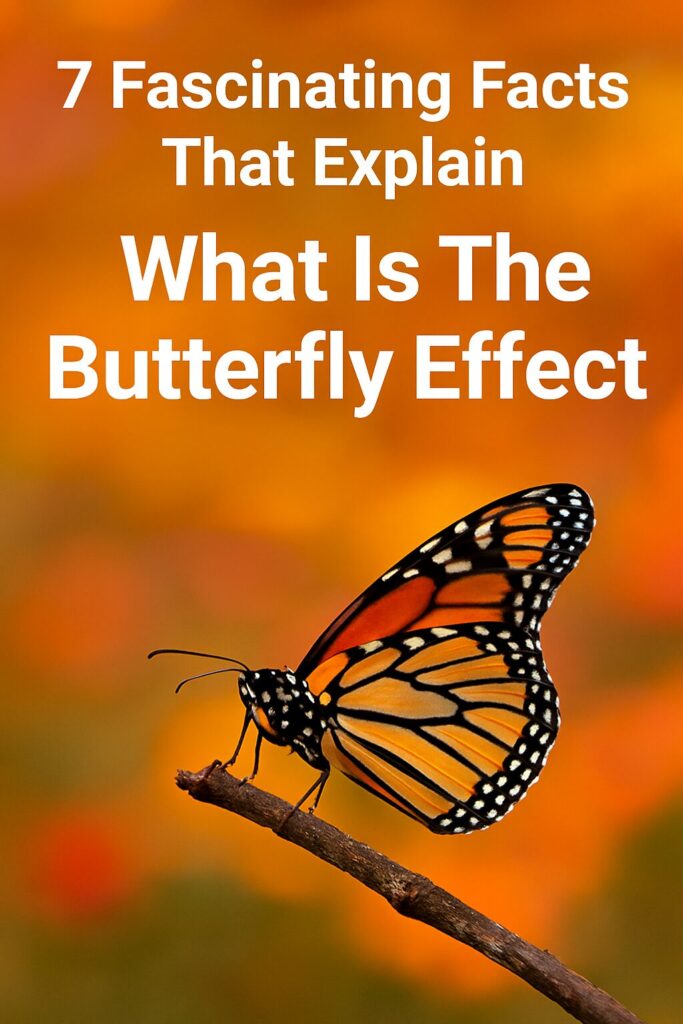
Curious what is the butterfly effect? In simple terms, it’s the idea that tiny changes in a complex system can lead to unexpectedly large outcomes over time. In this guide, you’ll get a clear answer to what is the butterfly effect, see everyday examples, and learn what it really means (and doesn’t mean) in science and life.
Quick Answer (in 3 lines)
- Definition: In chaotic systems, small differences in starting conditions can produce big differences later.
- Origin: Popularized by meteorologist Edward Lorenz while modeling weather in the 1960s.
- Takeaway: Predicting far into the future becomes hard because tiny uncertainties grow fast.
Where the Idea Came From
To understand what is the butterfly effect, start with Edward Lorenz. While running weather simulations, he rounded an input from 0.506127 to 0.506—and got a wildly different forecast. This showed “sensitive dependence on initial conditions,” a hallmark of chaos theory. The catchy metaphor—a butterfly flapping its wings in Brazil setting off a tornado in Texas—illustrates how small, local nudges can amplify through complex interactions.
Why Small Changes Can Snowball
In many systems—weather, ecosystems, markets, even personal habits—feedback loops and interactions are nonlinear. That means outputs aren’t proportional to inputs. A minuscule difference at the start can get magnified step by step. If you’re asking what is the butterfly effect in practical terms, it’s this: tiny tweaks can nudge a system onto a different path, and that path can diverge dramatically over time.
Everyday Examples
- Traffic: One driver taps the brakes; waves of slowdowns ripple backward for miles.
- Habits: A daily 10-minute practice compounds into skill differences that look massive a year later.
- Investing: Small fee or behavior differences (like holding vs. panic selling) can lead to huge long-term gaps.
- Health: Slight sleep changes alter appetite hormones, which shift diet choices and energy—outcomes multiply.
These aren’t magical effects; they’re compounding, path-dependent processes. That’s the heart of what is the butterfly effect in everyday life.
What It Doesn’t Mean
Understanding what is the butterfly effect also means avoiding myths:
- Not “anything causes anything”: Causality still matters. Systems have structures, constraints, and probabilities.
- Not pure randomness: Chaotic systems are deterministic—next states follow rules—but are hard to predict long-term.
- Not instant: Small differences need time and interactions to grow into visible outcomes.
Why Prediction Gets Hard
In chaotic systems, tiny measurement errors balloon. This is why medium-range weather forecasts degrade after about a week. If you’re exploring what is the butterfly effect in forecasting, it’s the idea that uncertainty amplifies—so we rely on ensembles, probabilities, and scenario ranges rather than single, precise long-term predictions.
How to Use the Idea Constructively
Once you grasp what is the butterfly effect, you can make it work for you:
- Small, consistent improvements: Micro-habits compound—aim for 1% better daily.
- Design for robustness: Build buffers and redundancy so small shocks don’t cascade into big failures.
- Nudge the leverage points: Identify actions with outsized ripple effects (communication norms, incentives, defaults).
- Think probabilistically: Plan for ranges of outcomes, not a single forecast.
Mini Demo (60 seconds)
Try this thought experiment to feel what is the butterfly effect: Pick a daily decision (bedtime, snack choice, 10-minute walk). Project two paths for 90 days—one with the tiny change, one without. Add the second-order effects (energy, mood, social time). You’ll see how small differences plausibly steer very different outcomes.
FAQ
Is the butterfly effect the same as chaos?
Chaos is a broader concept in which systems show sensitive dependence on initial conditions, strange attractors, and complex patterns. The butterfly effect is a famous feature of chaos, not the whole theory.
Does the butterfly effect mean long-term prediction is impossible?
Not impossible, but limited. Uncertainty grows over time, so we use probabilistic forecasts and scenarios instead of a single far-future prediction.
Is this just a metaphor?
No. In math and physics, models like the Lorenz system formally exhibit sensitive dependence. The metaphor helps explain what is the butterfly effect to non-specialists, but the phenomenon is real in many models and measured systems.
Can tiny actions always create huge results?
No—most tiny actions fade out. But in the right context (high leverage, feedback loops, tipping points), small inputs can produce surprisingly large effects.
Helpful Resources
- Wolfram MathWorld: Lorenz Attractor
- Encyclopaedia Britannica: Chaos Theory
- NOAA: Chaos Theory & Weather Forecasting
Explore More on AnswerNimbus
Want more clear explanations like this? Browse our Definitions section. Understanding what is the butterfly effect is a gateway to exploring how small changes shape complex results in science—and everyday life.
AnswerNimbus is an online knowledge hub providing step-by-step guides, how-to fixes, and clear explanations across technology, home, collectibles, and everyday curiosities. Our mission is to make useful information easy to find, understand, and apply.
